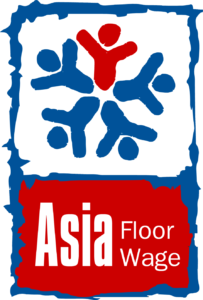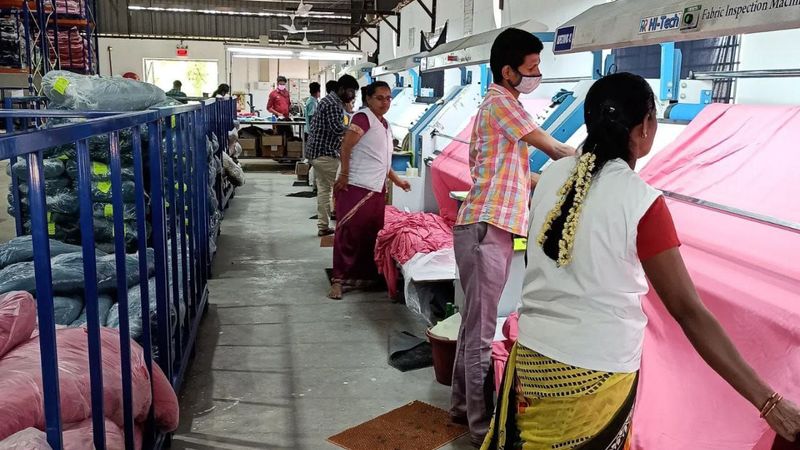Fighting for Justice: Soklin’s Battle After the Factory Closure
By Soklin
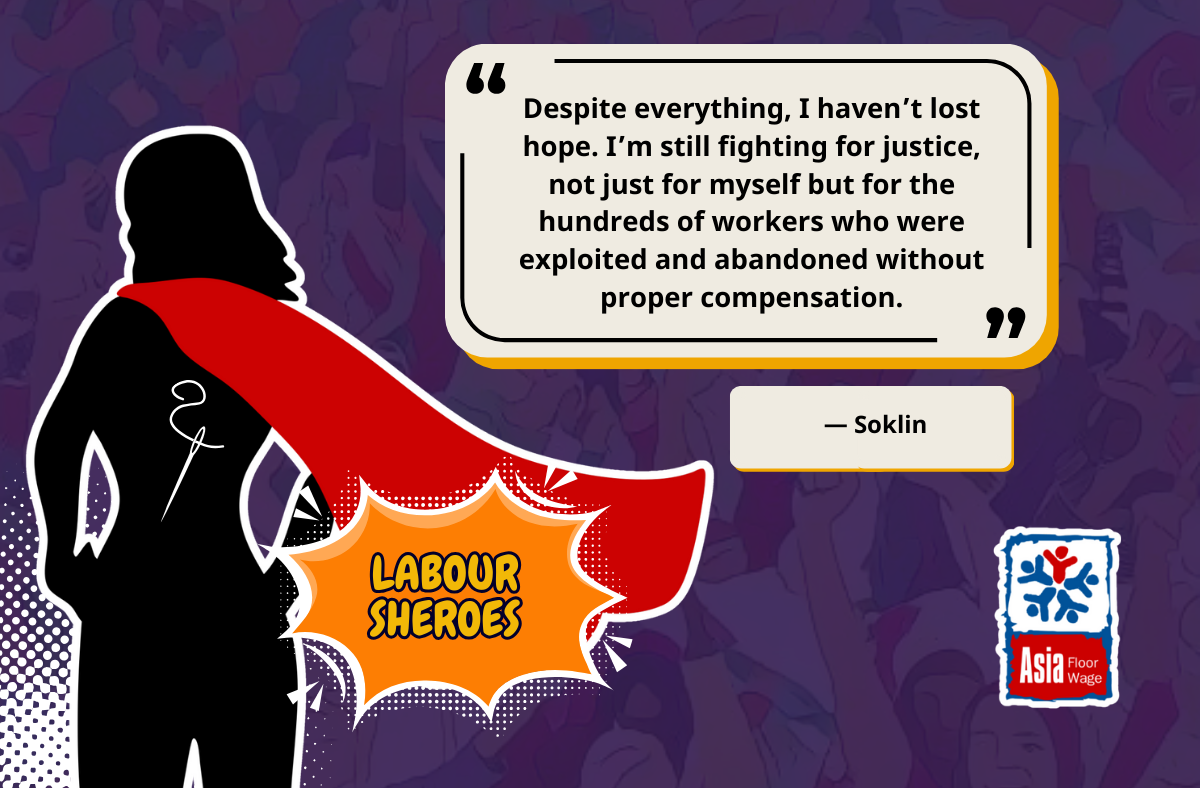
When JS Corp Phnom Penh abruptly shut its doors in October 2024, leaving over 1,000 workers without jobs or compensation, I knew I couldn’t stay silent. As a former worker and vice union leader, I had witnessed years of dedication and hard work from my fellow workers, only to see it all erased in an instant. This is my story—a story of resilience, injustice, and an unwavering fight for what’s right.
-
My name is Soklin, I am a 26-year-old mother of two and former worker at JS Corp, Phnom Penh. I grew up as the youngest of four siblings in Kandal province, while my parents ran a small business in Phnom Penh. My childhood was anything but stable—we moved frequently between the city and the province, which disrupted my education. By the time I was 17, I couldn’t keep up with my lessons and had to leave school.
A year later, I got married and soon became a mother to my first daughter. My husband’s income alone wasn’t enough to support our growing family, so when my daughter turned four, I decided to take a job in a garment factory. In 2018, I joined JS Corp Phnom Penh as a sewing assistant.
At the factory, I quickly gained a reputation for standing up for workers’ rights, which led to me becoming the vice union leader. For six years, I dedicated my time not just to my work, but also to advocating for fair treatment for all employees.
But in October 2024, everything changed. JS Corp Phnom Penh abruptly closed without any warning. The news hit me like a shockwave. Just weeks before, the factory had hired 200 daily workers and had nearly all employees working overtime for two straight months. None of it made sense. Something felt deeply wrong, and I couldn’t ignore the fact that over 1,000 workers, including myself, had been left with nothing.
When I tried to reach out to the employers, they simply claimed bankruptcy and directed me to another operational branch. But I couldn’t accept their excuses. I knew the devastating impact this closure would have on the livelihoods of so many workers. That’s when I decided to take action.
I began gathering evidence, listening to the stories of my fellow workers, and documenting everything I could. I sent this evidence directly to GAP, one of the major buyers of JS Corp’s products, hoping they would step in to address the injustice. But months later, I’m still waiting for a response.
The factory’s closure has put me in a difficult situation. I’m now burdened with mounting debt, and while I’m eligible for USD 1,000 in compensation, it’s a fraction of what I could have earned if the factory had continued operating legally. This financial loss has been devastating not just for me but for all the other workers who trusted in the stability of JS Corp Phnom Penh.
Despite everything, I haven’t lost hope. I’m still fighting for justice, not just for myself but for the hundreds of workers who were exploited and abandoned without proper compensation. I believe that GAP should take responsibility and recognize our struggle.
I refuse to stay silent about what happened. My story is not just about loss—it’s about resilience and standing up for what’s right. Until justice is served, I will continue this fight.
-
Soklin’s story is part of 'Labour Sheroes,' an initiative under the 16 Days of Activism campaign by Asia Floor Wage Alliance. Through this series, we share the stories of women garment workers from South and Southeast Asia who are breaking barriers, fighting against workplace violence and harassment, and leading the change for better working conditions in the global garment industry.
Breaking the Silence: Hafsa Bibi's Stand Against Workplace Harassment
By Hafsa Bibi
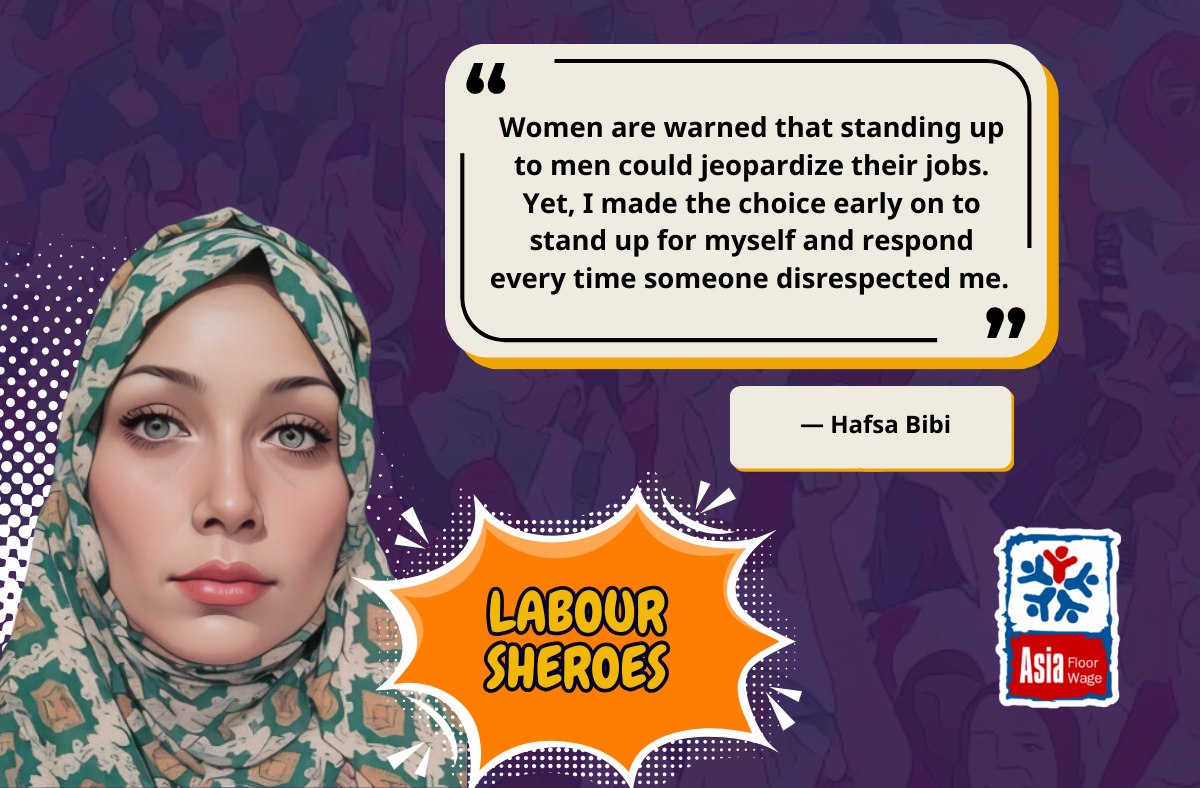
Hafsa Bibi’s life has been defined by challenges and resilience. From growing up without a father to fighting workplace harassment and providing for her children as a single mother, Hafsa’s journey reveals how courage and perseverance can transform hardship into strength. This is her story, told in her own words.
-
I lost my father when I was just 3 or 4 years old. At the time, my siblings were all young and couldn’t contribute financially, so my childhood was spent moving between relatives’ homes. Some days we stayed with my paternal uncle, and at other times we were at my maternal uncle's. My mother, a housewife with no experience in the working world, suddenly became the sole provider for our family. To keep us alive, she began leasing land to manage fruit gardens and sold the fruits at the market.
It was heartbreaking to watch my mother struggle so much to ensure we were safe, fed, and cared for. But her sacrifices came at a cost—my education. I wasn’t able to continue studying beyond secondary school. I don’t really remember my father; I only know his face through photographs. Growing up, my mother and those who cared for me became the most important people in my life.
At 16, I started working to support my mother. My first job was with Pakistan Telecom Ltd., a huge step to earn money and shield my mother from the mistreatment she faced in my brothers' homes after they got married. One of my brothers’ wives was especially disrespectful, and although my mother didn’t fully understand the context, I couldn’t let her endure it. I found work with the help of a friend, rented a small place, and moved in with my mother so she no longer had to live in such an environment.
A few years later, I met my husband, and we got married. But after just two years, he fell ill and developed harmful addictions, making it impossible for him to provide for the family. I became the sole earner.
Hoping to use my sewing skills, I tried to start stitching clothes from home, but in Faisalabad, there wasn’t much demand for tailoring as most people already knew how to stitch. By then, my children were 4 and 5 years old, and I had no choice but to seek work in the garment sector.
Those initial days were incredibly hard for me. Harassment began the moment I stepped out of my home. Men on the streets stared at me, some made inappropriate remarks, and on public transportation, others deliberately brushed against me. The factory environment wasn’t much better. During my first week, I kept my head down, avoiding eye contact, because I could sense people watching me. It was intimidating, but I forced myself to focus on my work and block out the behavior around me.
Gradually, I realized that if I let others’ actions affect me, it would only make me feel powerless. I told myself that toughening up would help me persevere. This mindset allowed me to navigate the challenges.
My supervisor often assigned me the most difficult tasks, likely assuming I’d struggle. However, since I already knew how to stitch, I completed them with ease. Surprised that I didn’t falter, they continued assigning me even tougher tasks and spent a lot of time standing over me, watching me work. The constant scrutiny was draining, but I kept going.
Unfair treatment is a regular part of being a woman in the garment sector. We often work as hard as the men, but we’re belittled or told to accept misconduct in silence. Women are warned that standing up to men could jeopardize their jobs. Yet, I made the choice early on to stand up for myself and respond every time someone disrespected me.
I believe that how people treat us starts with how we see ourselves. I decided that I would not feel inferior to the men working alongside me, and I started speaking up for myself. If someone insulted or harassed me, I made sure to reply firmly and loudly to show I wasn’t weak.
In our society, it’s common for women who work outside the home to face judgment and criticism. Men, on the other hand, are never questioned. I wanted to set an example for other women, to inspire them to demand respect. Whenever I responded to someone’s inappropriate behavior, I felt I was creating a safer workplace for myself and my colleagues.
At one factory, we had a supervisor who frequently disrespected women, using abusive language and even getting physical. One day, he grabbed a bundle of fabric from me and pushed me. Reacting instinctively, I slapped him, which led to a physical altercation. To defend myself, I picked up a pair of scissors.
The matter was reported to the factory owner. CCTV footage revealed the supervisor had manhandled me, and the owner supported me, firing the supervisor on the spot. That moment restored my faith in justice and gave me a sense of pride.
My greatest achievement is my ability to provide for myself and my children through my work. Raising them entirely on my own fills me with pride. I’ve become independent, self-reliant, and more determined than ever to create a better future for them.
-
Not all encounters are positive. Early in my career, the man at the stitching station next to me often made me uncomfortable, though I chose to ignore him. One day, he approached me and said his wife was seriously ill and asked for a loan for her treatment. I decided to help and promised to give him the money during lunch by going home to retrieve it. He insisted on coming with me, but I refused, knowing how it might look to others. I brought the money back and handed it to him.
A few days later, I learned he was spreading lies about me, insinuating an inappropriate relationship. This betrayal was devastating. I had helped him in good faith, and he had used it to attack my character.
Challenges like these are a reality for many women. It’s crucial to never give up, even when those you trust let you down or others try to undermine you. Women have incredible strength—they just need to recognize it. Speak up for yourself, protect your rights, and don’t let anyone make you feel less capable or valuable. Your resilience is your greatest weapon. Use it wisely, and don’t let anyone take it away from you.
-
Hafsa Bibi is the Vice President of the Textile Power Loom Garment Workers Union. Her story is part of 'Labour Sheroes,' an initiative under the 16 Days of Activism campaign by Asia Floor Wage Alliance. Through this series, we share the stories of women garment workers from South and Southeast Asia who are breaking barriers, fighting against workplace violence and harassment, and leading the change for better working conditions in the global garment industry.
From Cianjur's Mountains to Factory Floors: My Fight for Justice
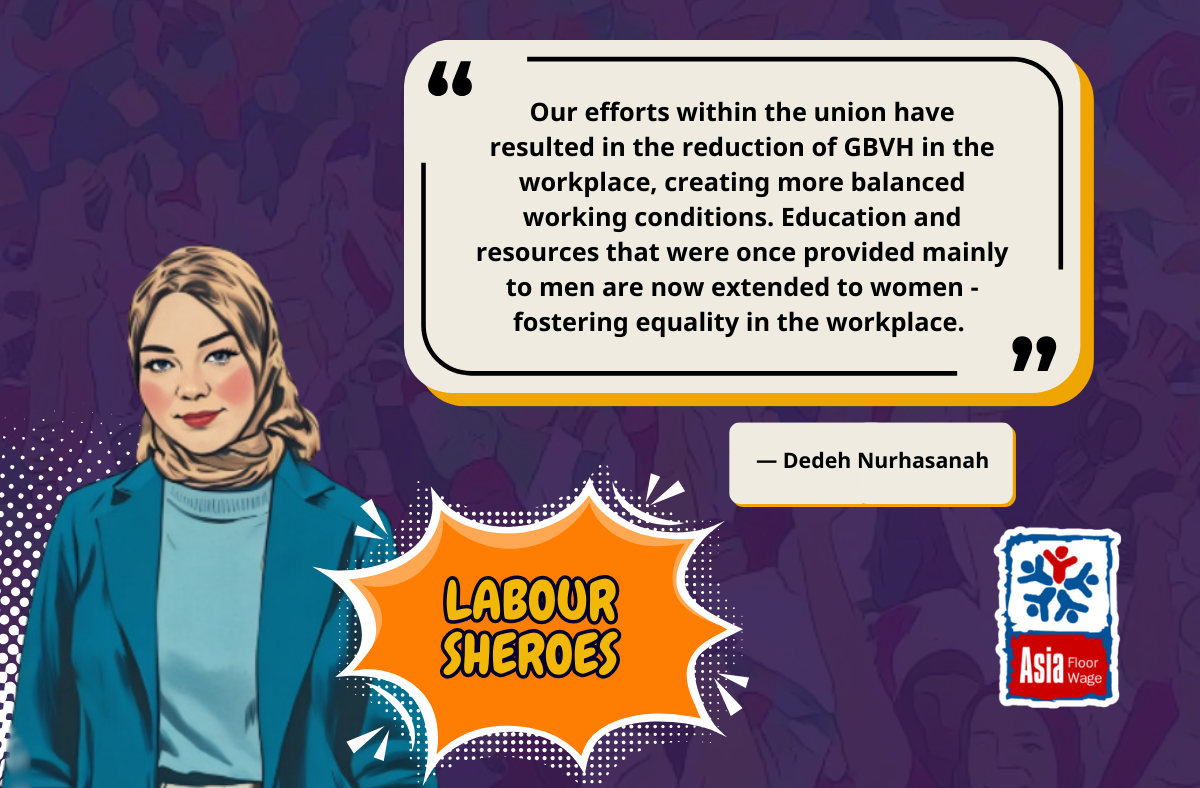
The mountains of Cianjur shaped my childhood, but it was the walls of garment factories that would shape my destiny. I am Dedeh Nurhasanah—Ndeh to those who know me—and this is my story of resilience, determination, and the ongoing battle against workplace injustice.
I grew up in Cianjur, where I was surrounded by mountains and a southern coastline. I lived with my parents and two sisters, and my childhood was a happy one. Although we lived simply, my sisters and I were able to complete our education and secure indoor work – sheltering us from unforgiving external elements.
Family is the most important aspect of my life—without them, I am nothing. I am someone who enjoys trying new things and engaging in different activities. My dream is to be smart, happy, and successful. If I could choose anything in this world, I would choose happiness and comfort in life.
In 2015, I learned about job openings at the Pou Yuen Indonesia Factory (PYI) and applied by sending my application through the nearest post office. I submitted my CV along with the required documents. A month later, I received a call to participate in a series of tests. Alhamdulillah, I passed and was accepted as an employee at PYI, where I also became a member of one of the factory’s unions.
Working at PYI has not always been smooth. I worked as a personal assistant to the AFL (production supervisor) of the building, where workers were often transferred to other production sites. These transfers often led workers to report their grievances to their unions, who in turn approached the AFL and me for clarification. My department was unique - housing multiple unions – which made resolving such issues even more complicated.
Life inside the factory is not always as it seems to outsiders. Gender-Based Violence and Harassment (GBVH) remains a frequent challenge, affecting workers in various ways. While some workers look the other way, others are directly affected. I have personally handled cases involving GBVH, including situations where women workers were too afraid or embarrassed to report harassment, fearing judgment or ridicule.
In one case, I advocated against harassment by interrogating the involved parties and witnesses, ensuring the case was monitored to prevent a repeat offence. While we always prioritised mediation but if it failed, we did not hesitate to escalate the issue in accordance with the Collective Bargaining Agreement (CBA).
Another significant case involved a rule requiring all supervisors to be women due to a perception that male supervisors were more rebellious. To address this, we educated male supervisors, emphasising that the misuse of authority or violation of regulations is not a gender-specific issue.
Our efforts within the union have positively impacted the reduction of GBVH in the workplace, creating more balanced working conditions. Education and resources that were once provided mainly to men are now extended to women - fostering equality in the workplace.
Eliminating GBVH in the workplace is not easy, but it is not impossible. The challenges range from handling work tasks to managing diverse personalities and perspectives. One of my toughest challenges was dealing with an excessively narcissistic person, which tested my patience. Eventually, I found that dealing with the matter with utmost patience was the most effective strategy to overcome this difficulty.
Amid the challenges, there have been moments of pride as well. In 2013, I worked for an outsourcing company at the Indonesia Epson Industri Factory in the EJIP Cikarang Industrial Area, Bekasi. When 8,000 Epson factory workers faced contract terminations and only 30 were selected for permanent roles, I was one of those candidates. After a month of rigorous testing and an interview with a psychologist and a Japanese planning manager, I was one of the three chosen for a permanent position, the only one placed in West Java. The pride I felt when I saw my parents’ smiles at my success was unforgettable.
My efforts are not just for myself; I strive to make a positive impact on others. To maintain a safe, comfortable, and equal work environment, continuous efforts are essential, such as updating knowledge on regulations and increasing self-confidence. I draw inspiration from a person who has a positive mindset and always says "YES” to opportunities, encouraging me to embrace every chance for growth.
Nothing in life is coincidental; everything results from choices. We should never waste opportunities, just as we should unite to fight workplace injustice. When we come together and act, our voices are heard. The support from CBAs, union membership, and the Anti-Violence Handling Team (TPAK) strengthens us. Problems won’t be solved through complaints alone; action, unity, and collective effort are essential for achieving justice.
Dedeh is a Shoe Worker from Cianjur, Indonesia. Her story is part of 'Labour Sheroes,' an initiative under the 16 Days of Activism campaign by Asia Floor Wage Alliance. Through this series, we share the stories of women garment workers from South and Southeast Asia who are breaking barriers, fighting against workplace violence and harassment, and leading the change for better working conditions in the global garment industry.
AFWA’s Quest for Living Wages and Gender Equality in the Garment Industry
The Asia Floor Wage Alliance has been a dedicated advocate for living wages in the garment industry since 2007. Its report, released in May 2023, titled "Towards a Woman-Centred Living Wage Beyond Borders," presents an in-depth explanation of AFWA's cross-border living wage methodology.
by Sinduri Sappanipillai, Asia Floor Wage Alliance (AFWA)
The garment industry employs countless individuals globally, with a significant majority being women. Low/poverty wages are an appalling fact of life for these hardworking people in the industry. Minimum wages, in many instances, languish below the poverty threshold, often failing to protect workers from the grim clutches of destitution.
The absence of a sufficient minimum wage results in numerous garment workers having to put in extended hours in order to earn extra pay/over time. This compels them to accept work even when working conditions are unsafe or when they are unwell, as they cannot afford to refuse. Additionally, the meagre wages force these workers to frequently resort to loans simply to make ends meet, leaving them with no savings to rely on in case of unemployment or unforeseen expenses.
Importantly, the financial burden of domestic unpaid labour and caregiving responsibilities, such as childrearing and looking after the elderly, which is typically shouldered by women within households, goes entirely unaddressed. Simultaneously, on the other end, global brands and retailers entrenched within the garment supply chain amass staggering profits. They capitalise on the cutthroat global competition for foreign direct investments, further exacerbating this stark divide between prosperity and hardship.
A living wage is the wage that is necessary for a worker to meet theirs and their family’s basic needs, and have a small amount of savings for unseen circumstances.
The Asia Floor Wage Alliance (AFWA) has been a dedicated advocate for living wages in the garment industry since 2007. Its report, released in May 2023, titled ‘Towards a Woman-Centred Living Wage Beyond Borders,’ presents an in-depth explanation of AFWA's cross-border living wage methodology, which has garnered international recognition and legitimacy since its public announcement in 2009.
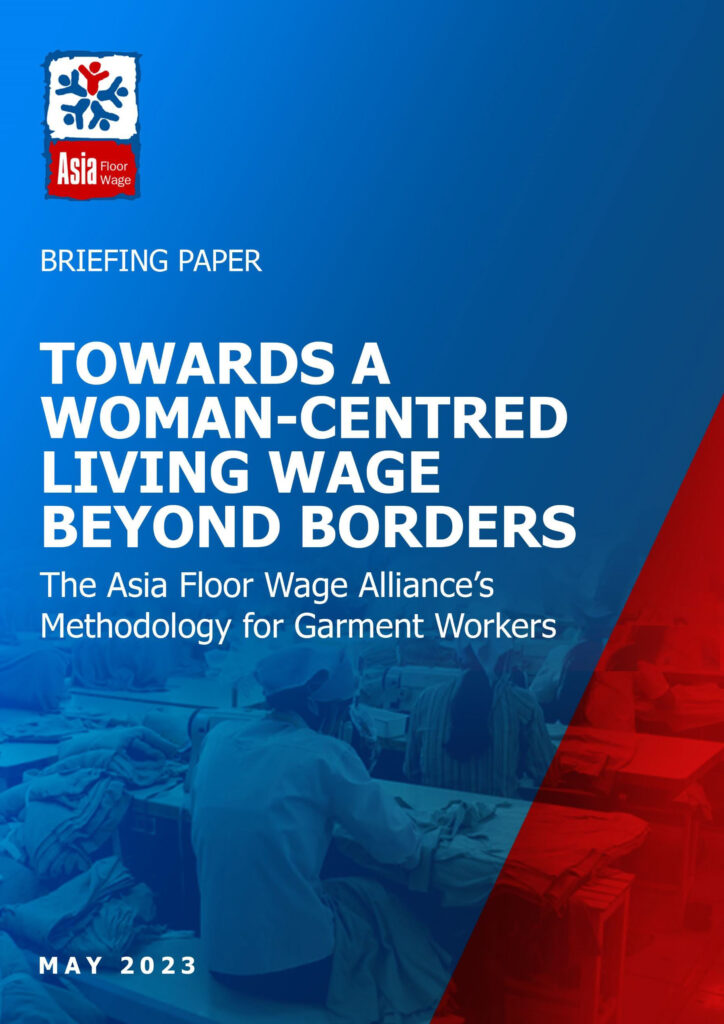
Debate and history - Minimum wage vs Living wage
The debate surrounding living wages in labour-intensive industries has regained prominence over the past two years. Historically, the International Labour Organisation (ILO) has played a crucial part in proposing conventions and recommendations to both developed and developing nations regarding the establishment of mechanisms and frameworks for determining minimum wages. The concept of a “minimum living wage” was introduced by the ILO, encompassing both the minimum level of remuneration and an acceptable standard of living. Initially, the emphasis leaned toward the former (”minimum”) and became intertwined with the World Bank's poverty alleviation program. However, it remained confined to this trajectory, failing to reach a universally acceptable standard of living for all workers.
AFWA’s approach to advocating for living wages
Before the inception of AFWA, brands within global garment supply chains had pre-established responses to garment workers' demands for living wages. They often asserted that they were already paying living wages, exploiting the confusion between minimum and living wages. Some would argue that there was no unified definition of a living wage within the labour movement, making it impractical to implement. AFWA reintroduced the concept of the "minimum living wage," and transformed the minimum living wage into an actionable concept and initiated a regional strategy by developing a consistent benchmark for living wages across borders. This explained the disparity between living wages and minimum wages, and revealed that the latter barely surpassed the poverty threshold.
The Asia Floor Wage (AFW) concept was developed as a regional wage formulation demand that would serve as a living wage in garment industry manufacturing in Asia. The methodology is significant for several reasons:
In AFWA’s methodology, a living wage is based on the needs of workers and their families, known as the “family wage”. This family-centric approach ensures that the living wage estimation aligns more accurately with the actual needs of workers and their families.
AFWA recognises that families come in varying sizes and compositions. Based on a survey of family sizes in Asia, AFW is based on a family comprising 3 adult consumption units. Each adult in a household is treated as 1 consumption unit and every child as half a consumption unit. Therefore, 3 consumption units can include 1 worker and 2 adult dependents, 2 adults and 2 children, or 1 adult and 4 children.
AFW is anchored in food costs based on the internationally accepted Engle’s Law that shows that lower-income countries (in this case, garment production countries) spend more on food costs than higher income countries. AFW is based on an adult, engaged in physical labour, needing 3,000Kcal a day to perform their work effectively (using the benchmark set by the Indonesian government). The ILO has recently confirmed this 15 years after AFW was first made public in 2009. In 2022, the ILO’s report on minimum wage methodology defined 2950 calories as the norm. AFWA calculates the living wage for a family in the garment industry by scaling up the monthly total of food and non-food costs by 3 consumption units.
AFWA's living wage methodology is a blend of bottom-up and top-down approaches. It draws on need-based surveys conducted among garment workers across various Asian countries, leveraging workers' unions and associations for labour organisation and negotiation with global brands regarding living wages.

Women-centred approach
AFWA's definition of a living wage adopts a women-centred perspective by steadfastly assuming a single-earner family for a standard 3-consumption family unit. This ensures a specific earner dependent ratio (1:3) which recognises the importance of unpaid household work, including care work, which is vital for families and primarily carried out by women, making it unique from any other existing methodologies.
A right to living wage
The estimation of a living wage is independent of the number of hours worked per day or per week. Given the prevalence of overtime work in the garment industry, it is vital that the living wage is based on a minimum number of working hours or a standard working week. AFWA determines the standard to be no more than 48 hours a week, 8 hours a day considering the 6-day workweek in the garment industry to cover basic needs and provide a decent standard of living.
In contrast, the current reality of garment workers is that most of them work long hours (often exceeding 10 hours per day) to inch their income just above the unsustainable poverty-level minimum wage. This situation perpetuates a cycle of debt and financial insecurity, as the wages earned are often insufficient to meet the basic needs. For instance, at the outset of the pandemic, brands abandoned workers in their supply chains and women were left to fend for themselves and their families through any means, which entailed reducing their consumption, taking on huge debt, and selling meagre assets to cover the costs of basic survival.
It is crucial to note that the living wage is exclusive of benefits and allowances such as healthcare, pension, provident fund, overtime wages and performance allowances. Given that the employers in the Asian garment factories generally do not bear these costs, it becomes important that the living wage is sufficient to meet basic needs regardless of employers' contributions.
Cross-country approach
AFWA's analytical approach and strategy have culminated in a methodology for formulating the unique cross-border living wage at the Asia level. The advocacy strategy hinges on a comprehensive analysis of power dynamics within the global garment supply chain, urging apparel brands to shift from coercively suppressing labour costs to progressively realising a living wage by adjusting their pricing mechanisms with suppliers. AFWA's regional living wage formulation alleviates a significant concern in production regions—the threat of brands relocating their operations and pitting one country against another.
Importantly, AFWA's living wage methodology offers a regionally tailored solution that carefully aligns with national economies without disrupting their competitiveness. The AFW concept uses the World Bank’s purchasing power parity (PPP) dollar as a common currency to compare a regional or cross-country floor for living wage.
AFW - Survey and findings
AFWA regularly updates the Asia Floor Wage (AFW), which represents the living wage, using food basket surveys conducted in various production countries across Asia. Additionally, more recently, AFWA has been conducting comprehensive consumption surveys. The latest survey - Household Consumption Expenditure Survey (HCES) was conducted in 2022.
The Findings
The calculation of the food cost is based on the daily caloric needs of an adult worker engaged in physically demanding work, set at a standardised value of 3000 calories. The non-food costs, encompassing expenses such as housing, clothing, healthcare, reproductive health, fuel, transportation, education, and more, are simplified in the AFW by representing them as a factor of the food cost. The ratio of food to non-food costs is 45:55, and this adjustment was reaffirmed in 2022.
The report's findings are based on surveys conducted with 1686 garment workers across seven countries: Bangladesh, Cambodia, Indonesia, India, Myanmar, Pakistan, and Sri Lanka, spanning 206 garment factories. The majority of those surveyed were women aged between 18 and 49, many of whom were responsible for supporting families with children under the age of 15. The Household Consumption and Expenditure Survey (HCSE) employed a structured interview schedule to gather data on consumption levels, categorised into six sections: (1) Basic worker profile, (2) Employment details, (3) Food consumption and related expenses, (4) Non-food consumption and related expenses, (5) Ownership of assets, and (6) Housing and living conditions.
The industry predominantly employs young workers. This raises significant concerns regarding the future prospects of women workers after they are pushed out of the industry at middle age, often with little or no social security and no savings due to having earned only poverty level minimum wages.
Differences in family size among workers across various countries are notable, with Indonesia having the lowest average family size at 3.6 and Pakistan registering the largest at 5, making it challenging for women workers to live with minimum wages. For example - In Pakistan, where the average family size is 5, women often face significant challenges as they are frequently the primary breadwinners earning minimum wage salaries. Additionally, 46% of households in Pakistan have at least one child aged 6-18 years, and 54% have children below the age of 6, making it even more challenging for women to provide for larger families while taking care of their children and households.
Despite the diverse composition of the garment workforce in each country, a striking similarity emerges in terms of cost-of-living expenditures and the constituents of both food and non-food items across the Asian region. This similarity justifies the selection of Asia as the unit of analysis for establishing a 45:55 ratio between food and non-food items, thereby enabling the creation of a consistent and regionally equivalent standard for estimating living wages.
A significant proportion of the workforce are engaged in temporary, casual, or irregular employment, with predominant presence of women with more dependents, and a lack or insufficiency of social security benefits.
The caloric statistics and the substantial disparities observed throughout the region give rise to profound concerns. For instance, in Sri Lanka, survey respondents reported consuming an average of 1834 Kcal/day at a cost of 271 LKR per day, which is among the lowest recorded figures. These consumption figures fall significantly below the international poverty thresholds, painting a stark and troubling picture of the widespread poverty and hunger that persists within the industry due to the current wage structures.
There is limited asset ownership, a prevalence of rented housing or a lack of ownership of homes or land, and restricted access to essential amenities such as sanitation facilities, and adequate healthcare infrastructure in urban areas.

Imagine the impact of having a living wage. Instead of working excessive hours just to make ends meet, the workers, predominantly women, would be able to earn a fair wage in a 48-hour workweek. The additional few hours of free time would be transformative, in terms of quality of life. This means having the opportunity to spend more time with their children and family, being present for important moments in their children's lives, nurturing and supporting them. They can have the joy of seeing their children grow, helping with homework, playing together and fostering strong family bonds while pursuing their own passions and interests.
Further, an extra few hours in terms of money can have a profound impact on the quality of life. It means being able to afford essential items like nutritious food, safe housing, and reliable transportation and healthcare.
As a reader, take a moment and share your thoughts on what having a living wage means to you. How does it enhance your life? How does it feel to have the financial stability to spend more time with loved ones, pursue your passions, or engage in activities that bring you joy? Feel free to share your thoughts and experiences!
Harassment, gender-based violence concerns addressed at factories: report
Written by Laurel Deppen for Fashion Dive (6 July 2023)
Read Article
